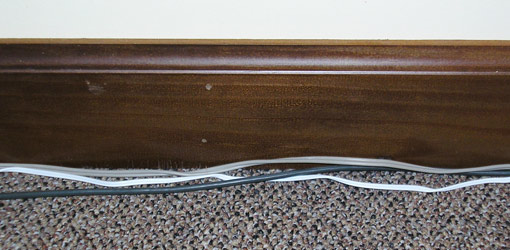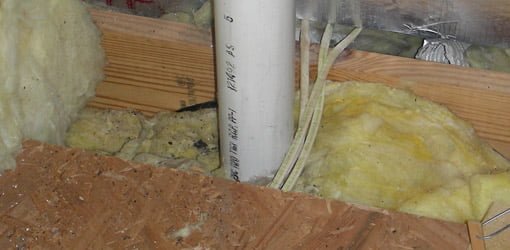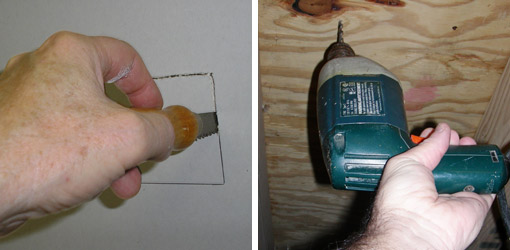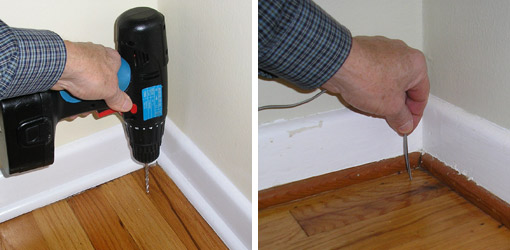How Much to Add a Window to an Existing Wall

Wires running along the floor are unsightly and may pose a safety hazard.
Need a new phone jack in your bedroom or installing speakers for your home theater system? While you could simply string the wires along the floor, it's best to snake the wires inside walls or under floors.
Wiring new construction before the drywall goes in is a piece of cake compared to fishing them through existing walls and floors. But with careful planning, a few special tools, and the right techniques, running wires in the wall of your home may be easier than you might think.
If you're not up to the challenge, consider running the wires in special hollow moldings that take the place of standard crown molding or quarter round.
Tools

Fish tape
Tools needed for running wires:
- Drill and bits
- Stud Finder
- Measuring Tape
- Flashlight
- Drywall keyhole Saw
- Fish Tape or Wire Coat Hanger
- Electrical Tape
- String and fishing weight
Before You Start
- Check Building Codes: Most areas allow homeowners to install their own low-voltage wiring—such as phone lines, computer network cable, and speaker wire—but check to be sure.
- Select Proper Wire or Cable: Make sure you use UL rated in-wall wiring that meets local building and fire codes—including CM, CMR, or CMP for computer networking, and CL2 or CL3 for speakers.
- Turn off the Power: Always turn off the breakers in your electrical box before you begin to reduce the chance of an electrical shock should you accidently cut or drill into existing wiring.
- Avoid Electrical Wires: Keep speaker, computer, and phone wires away from standard electrical wiring for safety reasons and to reduce interference.
- Choosing Walls: Whenever possible, run your wiring through interior walls, since exterior walls contain bracing and insulation.

Planning
Start by taking some time to consider the best location for the new wire. Eyeball existing electrical outlets, and make sure you're a safe distance away (the next stud over or more) to avoid interference or hitting existing wires.

Check the attic for unseen problems like pipes and wires hidden in the wall.
Next, examine the location from the attic, crawlspace, or basement to see if it's accessible and free of hidden wiring or plumbing. It may also be a good idea to scan the wall using a metal detecting stud finder to locate obstacles like copper plumbing pipes and metal ductwork that may be hidden in the wall.
Once your route has been mapped out, calculate the amount of wire or cable you'll need. Measure the distance from start to end, add a few extra feet for connections, and an additional 10% or so for unexpected problems or obstacles. The last thing you want is to come up short, so allow plenty extra and follow the old adage of "measure twice and cut once."
How to Fish Wires
- When you're ready to begin, turn off the power and use your stud finder to locate an open area in the wall between the studs.
- Drill a small pilot hole where the outlet will be, and use a straightened metal coat hanger to feel inside the wall for any unforeseen obstructions. If you're looking for an excuse to acquire the latest high-tech tool, a cable mounted inspection camera, such as the Ridgid SeeSnake, makes a great way to see inside a wall.
- If everything looks good, enlarge the hole for the wire or outlet box. Be sure to use an outlet boxes that's made to attach to an existing wall, but don't install it until the wire has been run.
- Now, go up to your attic, or down to the basement or crawlspace, and drill a hole in the top or bottom wall plate in the same wall cavity as the outlet.
- Attach the wire or cable to a fish tape or coat hanger using electrical tape, and feed it into the hole until it reaches the opening at the other end. If you're working from the attic, you can drop a weighted string down wall cavity, then attach the wire to the string and pull it through.
- Run the wire or cable to its destination. This may involve fishing it through another wall cavity, or out a small hole drilled in the floor.
- Feed the wire through the back of the outlet box, insert the box in the wall, and mount it in place.
- Strip the wires and attach them to the wall jack or run them to the device.

Cut hole in wall for outlet. Drill hole into wall plate.

Drill destination hole in floor. Run wire through hole.
Clean Up
If you drilled pilot holes that didn't work out, patch them with a dab of spackling compound. Sand the patch smooth when dry and touch up with matching paint. Fill any errant small holes in the floor with matching wood putty, and larger ones with a mixture of sanding dust and epoxy glue.
How Much to Add a Window to an Existing Wall
Source: https://todayshomeowner.com/how-to-run-wires-in-existing-walls-and-floors/